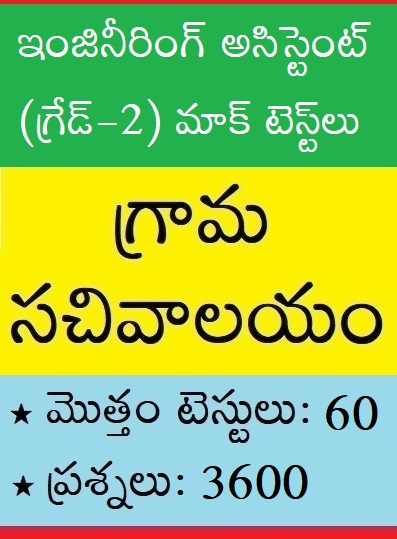Following are model questions for AP Grama Sachivalayam Engineering Assistant exam to be conducted in Andhra Pradesh. The model questions are from Engineering Mechanics topic of Engineering Assistants syllabus. Details of online exams also given below.
A body of mass ‘m’ moving with a constant velocity ‘v’ strikes another body of same mass moving with same velocity but in opposite direction. The common velocity of both the bodies after collision is
(A) v
(B) 2v
(C) 4v
(D) 8v
Answer: B
The centre of percussion of the homogeneous rod of length ‘L’ suspended at the top will be
(A) L/2
(B) L/3
(C) 3L/4
(D) 2L/3
Answer: D
The angle of inclination of the plane at which the body begins to move down the plane, is called
(A) Angle of friction
(B) Angle of repose
(C) Angle of projection
(D) None of these
Answer: A
Pick up wrong statement about friction force for dry surfaces. Friction force is
(A) Proportional to normal load between the surfaces
(B) Dependent on the materials of contact surface
(C) Proportional to velocity of sliding
(D) Independent of the area of contact surfaces
Answer: C
The term ‘Centroid’ is
(A) The same as centre of gravity
(B) The point of suspension
(C) The point of application of the resultant of all the forces tending to cause a body to rotate about a certain axis
(D) None of the above
Answer: A
The C.G. of a plane lamina will not be at its geometrical centre in the case of a
(A) Right angled triangle
(B) Equilateral triangle
(C) Square
(D) Circle
Answer: A
Forces are called coplanar when all of them acting on body lie in
(A) One point
(B) One plane
(C) Different planes
(D) Perpendicular planes
Answer: B
A rubber ball is dropped from a height of 2 m. If there is no loss of velocity after rebounding, the ball will rise to a height of
(A) 1 m
(B) 2 m
(C) 3 m
(D) 4 m
Answer: B
A weight of 1000 N can be lifted by an effort of 80 N. If the velocity ratio is 20, the machine is
(A) Reversible
(B) Non-reversible
(C) Ideal
(D) None of these
Answer: A
Centre of gravity of a solid cone lies on the axis at the height
(A) One fourth of the total height above base
(B) One third of the total height above base
(C) One-half of the total height above base
(D) Three eighth of the total height above the base
Answer: A
The resultant of two forces P and Q (such that P > Q) acting along the same straight line, but in opposite direction, is given by
(A) P + Q
(B) P – Q
(C) P / Q
(D) Q / P
Answer: B
When two elastic bodies collide with each other,
(A) The two bodies will momentarily come to rest after collision
(B) The two bodies tend to compress and deform at the surface of contact
(C) The two bodies begin to regain their original shape
(D) All of the above
Answer: D
The coefficient of friction depends upon
(A) Nature of surfaces
(B) Area of contact
(C) Shape of the surfaces
(D) All of the above
Answer: A
In determining stresses in frames by methods of sections, the frame is divided into two parts by an imaginary section drawn in such a way as not to cut more than
(A) Two members with unknown forces of the frame
(B) Three members with unknown forces of the frame
(C) Four members with unknown forces of the frame
(D) Three members with known forces of the frame
Answer: B
A machine having an efficiency greater than 50%, is known as
(A) Reversible machine
(B) Non-reversible machine
(C) Neither reversible nor non-reversible machine
(D) Ideal machine
Answer: A
The algebraic sum of moments of the forces forming couple about any point in their plane is
(A) Equal to the moment of the couple
(B) Constant
(C) Both of above are correct
(D) Both of above are wrong
Answer: A
